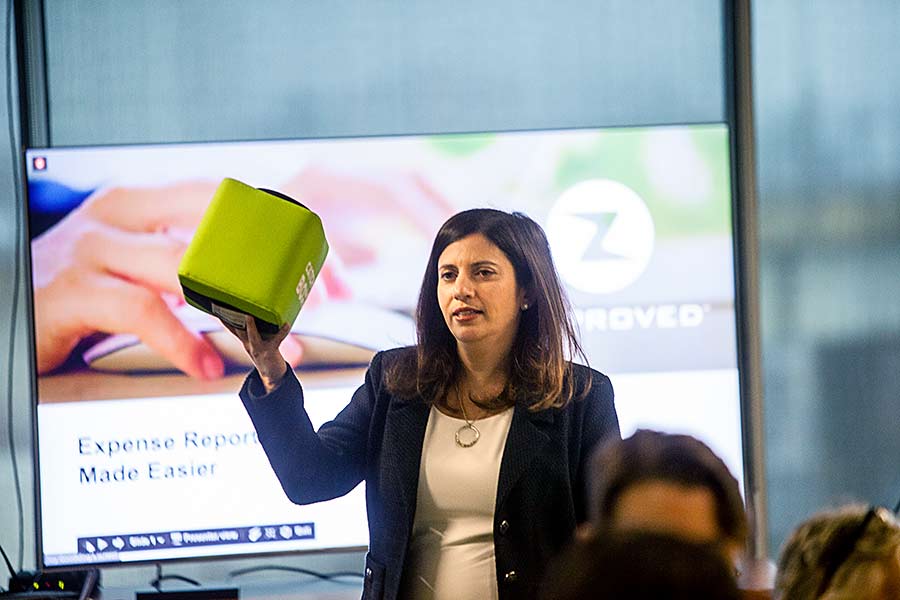How Monica Enand became the face of the post-Silicon Forest economy.
Monica Enand weaves through a throng of protestors shouting “F — cop apologists! F — cop apologists!” at anyone who will listen and into the Portland Building downtown.
She’s here in early March to return a favor to the city, the first customer of her booming Pearl District software company, Zapproved, by giving a talk to city employees about … well, she’s not quite sure.
“To be honest, I don’t even know what we’re doing here,” Enand says in the elevator on the way up to the ninth floor.
Maybe it’s about being a CEO, suggests her co-founder and marketing vice president, Chris Bright.
“I don’t know,” she laughs. “I say things and people do them.”
Enand, 45, can afford to be confident, even glib. Running a startup is equal parts planning and winging it; the job demands flexibility and quick thinking.
But she’s also comfortable speaking without a script because her entrepreneurial story — and backstory — tells itself.
***
The story begins with Enand building a company out of the rubble of the great recession, a tale of smarts, versatility and drive.
The backstory is the role she plays as a reluctant trailblazer: Enand is a female tech executive who leads by example rather than crusade, and a pragmatist who dabbles in political causes only to make the economic case for, say, open borders.
She certainly knows how to parry condescending mansplaining, sometimes from those who work for her — and she regularly mentors young women about how to navigate sexism in the tech workplace.
But she advocates for equity and diversity mostly by excelling at her job — an approach that offers a tantalizing glimpse of the postracial and postgender utopia Portland is trying to create.
Enand learned about entrepreneurship from her mother, who wedded in an arranged marriage in a patriarchal society, then defied her husband’s edict against launching her own business even as he lost job after job as an engineer in the evaporating textile industry.
She learned how to assimilate while growing up in West Virginia, where minorities were so rare that the family was featured on the front page of the local newspaper once. The headline: “Indians — from the country India!”
The experience has shaped her. Yet when Enand talks about immigration, she is resolutely apolitical. 
“Right now, the smartest people in the world come here to innovate and work in the tech industry,” she says, responding to a question about immigration restrictions under the Trump Administration. “That’s what makes us so competitive. That’s not partisan.”
***
Enand was invited to the city’s lunchtime speaker series because she built a company that prevailed when it should have foundered.
In January 2008, eight years after leaving her job at Intel, she launched Zapproved in Hillsboro with Elise Klein, who managed the office at Avnera Corporation, and Bright, formerly in marketing and communications at Pixelworks.
The idea was to build a software-as-service-provider that would solve a universal problem: The format “sucks at getting agreement,” as Enand puts it.
With Zapproved, Enand aimed to create a program that might help companies wrangle the increasingly unwieldy troves of data they manage; data that, if not properly stored and catalogued, could be costly, especially in the event of a lawsuit demanding disclosure.
Enand was already at a disadvantage: She knew nothing about raising money, pitching investors, hiring and building teams from scratch.
Then, a bigger problem landed: The startup’s first program hit the market in August 2008, two weeks before Lehman Brothers failed.
Suddenly, better data management sounded to panicking CEOs like a nice idea, but not a necessary one.
“They founded the company at about the worst possible time to found a company,” says Allen Alley, the founder and CEO of Pixelworks and one of Zapproved’s first investors.
“Right before the great recession, they had to pivot in the middle of it, and on very little vested capital.”
Zapproved wasn’t a Silicon Valley startup with $40 million in the bank, Alley says.
“It was an almost bootstrapped company with several angel investors. She had to be incredibly resourceful and clever, a great manager of cash, and somebody that listened to and responded to the market quickly.”
Enand shifted strategy, and fast. Cash-strapped companies might consider data management a tool they could invest in later, but another industry is required to maintain immaculate records: law firms.
So Enand and her team developed a product called Legal Hold Pro, a cloud-based software that preserves and organizes data required during lawsuit discovery.
“When there’s a recession,” Enand said at City Hall, “people sue each other more. Not that I root for that, but that’s how we survived.”
The plan worked, though not right away. Enand and her husband, fellow Intel veteran Sanjay Natarajan, had agreed she would take no more than $100,000 out of their savings account.
“I kept going back to him,” she said in a speech last year at the Oregon Entrepreneurs Network’s annual summit.
“I have to take a little more, until one day he said: ‘When does this end?’ I thought, am I a gambling addict? What’s happened to me? I felt like maybe there was something very dangerous going on.”

This was no passing concern. Once he discovered the travel perks associated with visiting Atlantic City casinos, Enand’s father spent more than a little time in the gaming mecca. His habit never threatened the family finances, Enand says.
But it did make her question her own addictive tendencies.
In search of better opportunities, her father had come to America to earn a master’s degree in analytical chemistry.
He believed it critical that his children assimilate, so he forbade speaking Hindu in their home and gave Enand, her sister and her two older brothers anglicized names.
The only sibling to be born in the U.S., Enand fielded questions from puzzled classmates at school:
“Did your family live in a mud hut?” and “Why does your house smell funny?” and the most common, “Why does your mom have a dot on her forehead?” The result: “We were pretty good at assimilating.”
As her father’s career languished, her mother secretly socked money away in a can in the kitchen. And in the mid-1980s, despite his opposition, she started a gift shop in a mall.
“Are you crazy? You can’t run a business,” was her dad’s first reaction. “She stood up to him,” Enand says. “What was he going to do? He’d been laid off eight times.” Before long, he joined the family business.
***
Enand’s story arc in many ways parallels that of her mother’s. In 1989 she enrolled at Carnegie Mellon, where she was one of three women in her electrical engineering class. It was there that she met Natarajan, who was getting his Ph.D. and also studying electrical and computer engineering.
After graduating in 1993, she landed a job in Portland at Intel, also surrounded by thousands of male co-workers.
Seven years later, Enand left Intel to start a family, and once again she was viewed as an outsider, this time in Portland, a city noted for its discomfiting mix of progressive politics and provincial cultural attitudes.
“People started treating me like an idiot” for being a mom, she says. “I was like: ‘I’m not any dumber, am I?’”
Enand earned an MBA from the University of Portland in 2004, and then decided she wanted to go back to work. She took a sales job at IBM, managing software development teams in the U.S., Canada and India for eight years and helping increase sales by $40 million in 2006 alone.
She felt she had stepped into a time warp. Technology had advanced at a rapid pace, and the changes made her return to the workforce confusing.
“The forms of communication, email etiquette, web meetings, calendar apps,” she says. “There were all these new things people did to communicate with each other in daily life.”
Catching up was one battle. Becoming self-assured was another. “It was the hardest part of my life, just trying not to lose my confidence,” she says.
In 2008, after a yearlong stint running business development at Avnera Corporation, Enand and Bright started Zapproved. Her business-savvy mom questioned the risk — often. Indian culture prizes professions, not entrepreneurship, she says.
“My mom would tell me all the time I shouldn’t have left this great job,” she says. “I was motivated because I was really afraid of failure.”
But she didn’t fail. Instead, says Steve Sharp, founder of the semiconductor company TriQuint and one of Zapproved’s early investors, “she got in there and learned. She’s very persistent. She gets what she wants.”
Enand and Bright focused on guerrilla marketing and efficiency.
In the end, they got what they wanted. Zapproved has grown from two employees to 92, with 20 job openings as March 2017; raised $17.5 million; and now serves more than 250 customers.
In 2016 alone, the company landed 61 new clients, 18 of them Fortune 500 members. companies including Yahoo, Sprint and General Dynamics. The company’s revenue has grown by 261% from 2013 to 2016, Bright says.
Each week Enand gathers her staff in an all-hands meeting over a catered lunch in Zapproved’s cafeteria, which is attached to a small meeting room that houses a symbolic couch — the one she and Bright used when Zapproved’s office was Enand’s living room.
At 4’10”, she doesn’t  take up much physical space, a quality that combined with her gender has made it tough to be taken seriously when asking investors for money.
take up much physical space, a quality that combined with her gender has made it tough to be taken seriously when asking investors for money.
But she seems to have found a way to turn these qualities into strengths. She bursts with charm, energy and empathy.
Before visitors can pass the reception desk at Zapproved, they must sign an electronic nondisclosure agreement. Once inside, there are few secrets.
During a recent catered lunch, Enand tosses a soft-sided microphone called a Catchbox from one employee to the next, the tech version of “pass the conch,” to discuss the day’s agenda items: vacation policy, expense reports and other routine business.
Halfway through the lunch, Mike Keister, the company’s newly installed vice president of sales, takes the microphone for an important update.
“There’s $410,000 worth of new business we’ve won so far this quarter,” he beams. “And we’ve identified $800,000 in possible revenue this month. We’re shooting to make this another record quarter.”
Most privately held companies play it close to the vest, keeping even their employees in the dark about finance and operations. At Zapproved, transparency is the modus operandi.
“We share board decks with the entire employee base,” she told workers at the City Hall meeting. “All the revenue numbers, we share when we bring on a new customer — everybody knows everything.”
Openness includes bad news as well. Every employee at Zapproved understands that the company had a bearish January, with sales stagnant in a typical but nonetheless critical set of winter doldrums.
“It’s been kind of a knock-down, drag-out quarter to get to this point,” Keister says. “It’s not unusual for enterprise companies coming off of momentum in December. You essentially start over.”
Enand “actively” doesn’t pay her employees the highest salaries in the region, she says, because that would allow the company to “cheat” on its culture.
“It would make us lazy,” she said during her City Hall presentation. “If your culture is robust, people will take a little less pay. Now we have people there who want to be there, who aren’t necessarily there for the highest paycheck.”
For higher-level hires, though, culture isn’t enough. Portland software companies are thriving, but there is still a dearth of executive talent. “I can name the number of qualified people on one hand,” Enand said at the meeting at City Hall.
If they’ve got a track record running a successful tech company, they’re getting paid handsomely to live a good life in the Bay Area, and it’s tough to lure prospects north. It’s also hard to hire engineers, but that’s true everywhere, not just in Portland, she said.
“I really wish there was a world-class university here locally,” she says.
Diversity, of course, is another challenge. Homogeneity has become one of the top sources of angst in the tech industry (second is the impact of the industry on housing prices), and virtually every employer in Portland is tweaking organizational structures to create a more representative workforce. Enand’s company hosts monthly workshops on inclusion and diversity, and Enand herself is full of stories about gender bias.
“When you try to raise money, you’re going to get rejected 10 times as often,” Enand says. “People will say: ‘We don’t think you’re going to be successful.’ Or ‘We don’t think you understand how hard it is to create a business.’ They were right, by the way. But maybe they assume men aren’t as naive.”
For years Enand felt certain science and tech would organically become more welcoming. “Then I realized it’s not getting better. Even if you can get girls into these fields, once they get to work, they quit.”
But for all of the gender troubles Enand has faced, her advice to young women is surprisingly contrarian: Don’t exhaust yourself constantly fighting the patriarchy. Enand relays a story about being lectured by another CEO — about how to handle offensive comments.
“He told me I should say something. That people want to be corrected,” she remembers. “I told him, ‘That’s your male privilege.’ When I correct someone, I’m labeled a sensitive bitch.”
Enand doesn’t have to launch a specific diversity crusade to be effective, says Rick Turoczy, editor of the tech blog Silicon Florist. She just needs to serve as a role model.
“We need people who are visible who then encourage others to pursue similar paths,” Turoczy says. “Monica takes that on exceptionally well.”
Last summer Enand gave a diversity talk at the University of Oregon for high school girls headed to a weeklong convention for young entrepreneurs. After the talk was over, one of the students asked for advice about how to handle the overt and unconscious bias.
“I’m sorry to tell you this,” Enand said, “but you need to play to it a little bit. Do smile; do say, ‘I’m not sure.’ Do all the stupid little things women learn to do. Give credit to the boys in your group. I’m not saying you should live your whole life that way, but you’re trying to get your thing done.”
Relocating to the Pearl District was another pragmatic move on Enand’s part. The company’s urban headquarters telegraphs a shift in the epicenter of Portland’s tech cluster — from Silicon Forest to the central city.
Dozens of tech firms from Zoom+ to Lattice Semiconductor have relocated from the Hillsboro-Beaverton corridor in the past few years. (Zapproved relocated in 2015.) The shift is driven by Portland’s lively dining and shopping scene and high-density bike and pedestrian-friendly urban environment, all high on the priority list for tech employees.
“Some people wouldn’t even interview with us because of our [Hillsboro] location,” Enand told Oregon Business last year.
Her own family moved to the Pearl about four months before the company, “mostly driven by the kids,” she says. Her two children, 18 and 16, “love being in the city,” and they attend Portland’s Catlin Gabel.
Enand remembers a picture on the front page of The Oregonian showing a classroom in Beaverton with 45 students in it, some of them sitting against the window because there weren’t enough chairs.
“I thought that was outrageous,” she says. “Public schools aren’t really an option.”
One of the kids’ teachers at Catlin Gabel, Meredith Goddard, reached out to Enand a few years ago to see if she had any ideas about how to teach entrepreneurship to her students.
Months later, the two had co-founded a startup camp. Now in its fourth year, the camp invites hundreds of students across the city to a series of workshops held over a three-day weekend.
“Monica does all the fundraising,” Goddard says, and helps recruit the 40 different mentors who attend. “I don’t know how she’s as productive as she is, but it’s inspiring.”
Enand is also a mentor herself. Two of her recent mentees launched a startup capitalizing on the growing awareness about the health risks involved in sitting at a (school) desk all day.
Seventeen-year-old Angela Liu and Allie Rosenfeld created a simple addition to any desk, a U-shaped piece of fabricated metal that can be placed atop a regular desk, allowing students to stand.

The students pitched their idea at TechfestNW a year ago, but before they did so, Enand stayed after work on a Friday evening to help them with the presentation.
Liu describes one piece of advice: ditch their boring boilerplate opener — “Hi, my name is…” — in favor of a compelling start.
The final pitch opened with an engaging question for the audience: “What are you doing right now?” The answer, of course, was “sitting down.”
That kind of connect-the-dots approach defines Enand’s leadership style, colleagues say.
Enand is “really good at thinking about the big picture, about six months, three years, where to take the company,” says Jon Gelsey, CEO of AuthO (Enand serves on AuthO’s board).
For her part, Enand says she enjoys watching Zapproved grow; as for long-term thinking, she has no interest in taking the company public.
“It’s not fashionable to go public anymore. It’s too difficult to be innovative,” she says. “I love being a privately held company. You can think long term and invest long term.”
The long view doesn’t necessarily mean she’ll stay on as CEO, either.
“I feel privileged to have this position, but founder CEOs don’t tend to last long,” she says. “The skill of being a founder is totally different than the skill of running a company.”
Right now she’s focused on making Zapproved’s products work well; in the past two years, the company has expanded the product line from the initial Legal Hold Pro software to new tools that collect and organize the data required to comply with court demands for discovery.
The qualities that makes Enand a good CEO would also serve her well in politics, a field she says she has little interest in pursuing. But the forces pushing her to take policy positions are strong.
As Portland’s old-guard business leaders (many in the professional services sector) begin to retire, a new generation of tech CEOs will have to navigate what it means to participate in policy discussions.
Enand is already becoming a fixture in Oregon leadership circles; she has been a speaker at the Oregon Leadership Summit, the annual gala for state power players, and was vocal in her opposition to last year’s controversial corporate tax-receipts measure.
And this year she thrust herself into the center of a political maelstrom by signing onto a project with well-known New York judge Shira Scheindlin to provide free legal representation to immigrants facing deportation, a direct rebuttal to President Trump’s aggressive posturing toward outsiders.
Beyond those commitments, she insists she has no interest in running for office. “Politics is so slow,” she says. “I think it would be boring.”
Efforts like the American Immigrant Representation Project should be nonpartisan, she says. “Forget about right and wrong: Our economy is threatened if we’re not the leader in where the big brains want to come.”
Immigration is an economic issue. It’s also highly politicized and partisan. Clearly, Enand prefers running a company and rais ing a family to getting sucked into identity politics.
But whether she likes it or not, Enand is a poster child for the benefits of opening national borders — and, for that matter, gender diversity. Policy making is slow, but Monica Enand moves at warp speed.
The city of Portland is doing its best to catch up.





